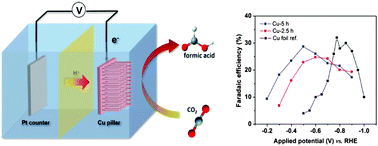Hierarchical Cu pillar electrodes for electrochemical CO2 reduction to formic acid with low overpotential†
Abstract
To achieve high performance of electrochemical CO2 reduction, a series of Cu pillar electrodes (Cu-2.5 h, Cu-5 h) were fabricated by using an electrodeposition method, and then their catalytic activities and reaction mechanisms were investigated. The series of Cu pillar electrodes exhibited improved electrocatalytic activities toward CO2 reduction to formic acid (HCOOH) as Cu pillars on electrodes developed. The Cu-5 h electrode performed well with a 28% Faradaic efficiency for formic acid at −0.5 V (vs. RHE). X-ray diffraction (XRD) analysis indicated that the enhanced catalytic activities were primarily attributable to the increased (111) facet, which is energetically favourable for the production of HCOOH. Also, ultraviolet photoelectron spectroscopy (UPS) and in situ electrochemical impedance spectroscopy (EIS) results suggested that the series of Cu pillar structure electrodes improved the electron transfer to adsorbed CO2 due to the decreased work function of the Cu pillar structure.


 Please wait while we load your content...
Please wait while we load your content...